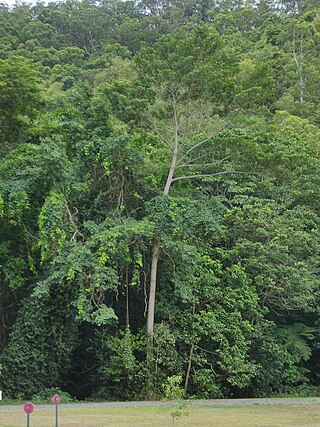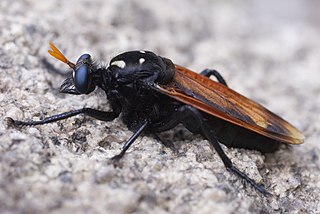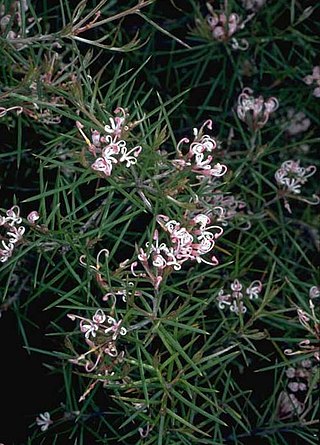
The white-bellied sea eagle, also known as the white-breasted sea eagle, is a large diurnal bird of prey in the family Accipitridae. Originally described by Johann Friedrich Gmelin in 1788, it is closely related to Sanford's sea eagle of the Solomon Islands, and the two are considered a superspecies. A distinctive bird, the adult white-bellied sea eagle has a white head, breast, under-wing coverts and tail. The upper parts are grey and the black under-wing flight feathers contrast with the white coverts. The tail is short and wedge-shaped as in all Haliaeetinae species. Like many raptors, the female is larger than the male, and can measure up to 90 cm (35 in) long with a wingspan of up to 2.2 m (7.2 ft), and weigh 4.5 kg (9.9 lb). Immature birds have brown plumage, which is gradually replaced by white until the age of five or six years. The call is a loud goose-like honking.

The grey currawong is a large passerine bird native to southern Australia, including Tasmania. One of three currawong species in the genus Strepera, it is closely related to the butcherbirds and Australian magpie of the family Artamidae. It is a large crow-like bird, around 48 cm (19 in) long on average; with yellow irises, a heavy bill, dark plumage with white undertail and wing patches. The male and female are similar in appearance. Six subspecies are recognised and are distinguished by overall plumage colour, which ranges from slate-grey for the nominate from New South Wales and eastern Victoria and subspecies plumbea from Western Australia, to sooty black for the clinking currawong of Tasmania and subspecies halmaturina from Kangaroo Island. All grey currawongs have a loud distinctive ringing or clinking call.

The southern fulmar is a seabird of the Southern Hemisphere. Along with the northern fulmar, F. glacialis, it belongs to the fulmar genus Fulmarus in the family Procellariidae, the true petrels. It is also known as the Antarctic fulmar or silver-grey fulmar.

The banded hare-wallaby, mernine, or munning is a marsupial currently found on the islands of Bernier and Dorre off western Australia. Reintroduced populations have recently been established on islands and fenced mainland sites, including Faure Island and Wadderin Sanctuary near Narembeen in the central wheatbelt.

The desert rat-kangaroo, also called the buff-nosed rat-kangaroo, plains rat-kangaroo or oolacunta, is an extinct small hopping marsupial endemic to desert regions of Central Australia. It was first recorded in the early 1840s and described by John Gould in London in 1843, on the basis of three specimens sent to him by George Grey, the governor of South Australia at the time.

The Asilidae are the robber fly family, also called assassin flies. They are powerfully built, bristly flies with a short, stout proboscis enclosing the sharp, sucking hypopharynx. The name "robber flies" reflects their expert predatory habits; they feed mainly or exclusively on other insects and, as a rule, they wait in ambush and catch their prey in flight.

The white-browed scrubwren is a passerine bird found on the New England Tablelands and coastal areas of Australia. Placed in the family Pardalotidae in the Sibley-Ahlquist taxonomy, this has met with opposition and indeed is now known to be wrong; they rather belong to the independent family Acanthizidae.

The King Island emu is an extinct subspecies of emu that was endemic to King Island, in the Bass Strait between mainland Australia and Tasmania. Its closest relative may be the extinct Tasmanian emu, as they belonged to a single population until less than 14,000 years ago when Tasmania and King Island were still connected. The small size of the King Island emu may be an example of insular dwarfism. The King Island emu was the smallest of all known emus and had darker plumage than the mainland emu. It was black and brown and had naked blue skin on the neck, and its chicks were striped like those on the mainland. The subspecies was distinct from the likewise small and extinct Kangaroo Island emu in a number of osteological details, including size. The behaviour of the King Island emu probably did not differ much from that of the mainland emu. The birds gathered in flocks to forage and during breeding time. They fed on berries, grass and seaweed. They ran swiftly and could defend themselves by kicking. The nest was shallow and consisted of dead leaves and moss. Seven to nine eggs were laid, which were incubated by both parents.

The tomtit is a small passerine bird in the family Petroicidae, the Australasian robins. It is endemic to the islands of New Zealand, ranging across the main islands as well as several of the outlying islands. In the Māori language, the North Island tomtit is known as miromiro and the South Island tomtit is known as ngirungiru. This bird has several other Māori and English names as well. There are several subspecies showing considerable variation in plumage and size. The species is not threatened and has adapted to the changes made to New Zealand's biodiversity.

The red-capped robin is a small passerine bird native to Australia. Found in drier regions across much of the continent, it inhabits scrub and open woodland. Like many brightly coloured robins of the family Petroicidae, it is sexually dimorphic. Measuring 10.5–12.5 cm (4.1–4.9 in) in length, the robin has a small, thin, black bill, and dark brown eyes and legs. The male has a distinctive red cap and red breast, black upperparts, and a black tail with white tips. The underparts and shoulders are white. The female is an undistinguished grey-brown. This species uses a variety of songs, and males generally sing to advertise territories and attract females. Birds are encountered in pairs or small groups, but the social behaviour has been little studied.

The crescent honeyeater is a passerine bird of the honeyeater family Meliphagidae native to southeastern Australia. A member of the genus Phylidonyris, it is most closely related to the common New Holland honeyeater and the white-cheeked honeyeater. Two subspecies are recognized, with P. p. halmaturinus restricted in range to Kangaroo Island and the Mount Lofty Ranges in South Australia.

Elaeocarpus grandis, commonly known as the blue quandong, silver quandong or blue fig, is a species of flowering plant in the family Elaeocarpaceae which was first described in 1860. It is a large buttressed tree native to the coastal rainforests of northeastern Australia. The validity of this taxon is disputed, with some authorities accepting it and others presenting it as Elaeocarpus angustifolius.

Cyril Tenison White was an Australian botanist.

Blepharotes coriarius, the giant yellow robber fly, is a species of large predatory fly from Australia in the family Asilidae. It was described by the German naturalist Christian Rudolph Wilhelm Wiedemann in 1830.
Ironomyiidae is a small family of flies in the order Diptera. Historically, they had been included in the family Platypezidae, and includes three extant species within the single extant genus Ironomyia endemic to Australia and a number of extinct fossil genera from North America and Asia extending back to the Early Cretaceous.

Prolepsis is an insect genus of mainly neotropical Diptera in the family Asilidae or robber flies.

Efferia is an insect genus of mainly neotropical and nearctic Diptera in the family Asilidae or robber flies. It is one of the most species-rich genera of Asilidae, with particularly high diversity in arid or semi-arid ecosystems of the New World.

Diogmites is a genus of mainly neotropical flies in the family Asilidae or robber flies.

Grevillea halmaturina is a species of flowering plant in the family Proteaceae and is endemic to South Australia. It is a prickly, spreading to erect shrub with sharply-pointed, linear to more or less-cylindrical leaves and large groups of white to pale pink flowers.


















